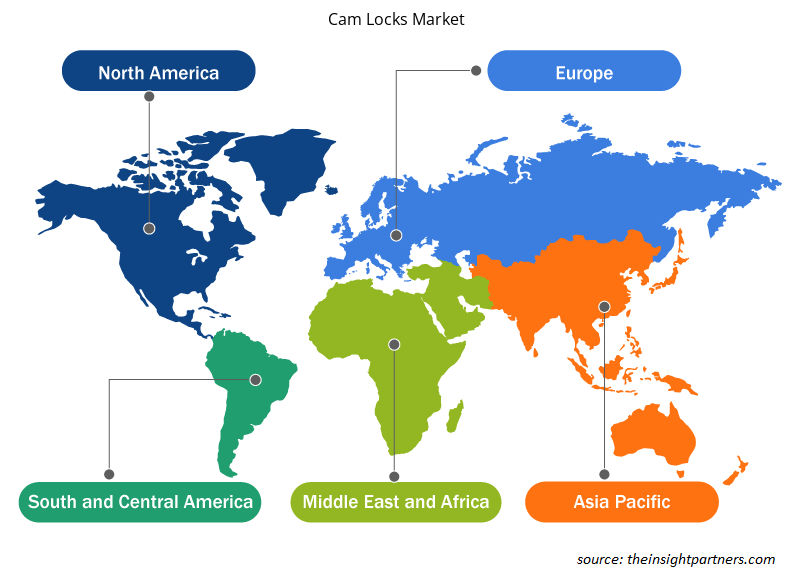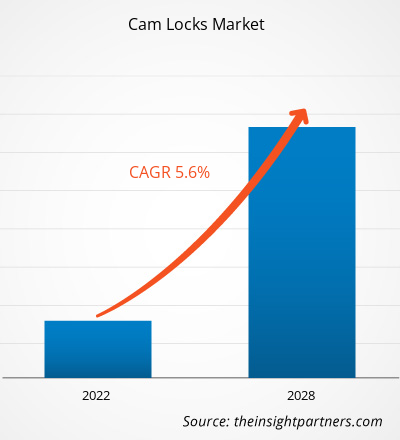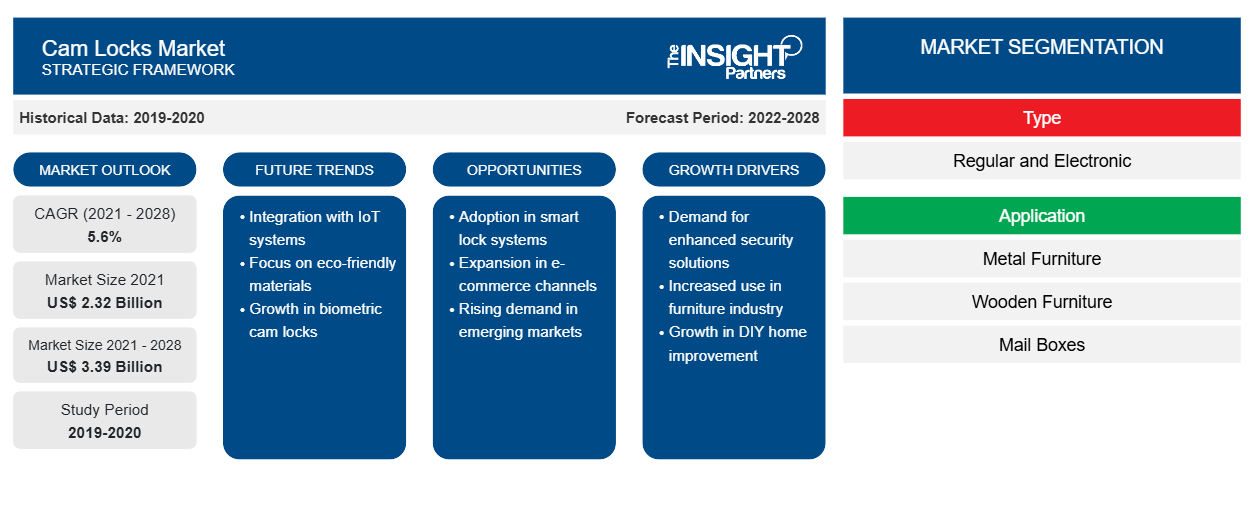بلغت قيمة سوق أقفال الكاميرا 2،319.1 مليون دولار أمريكي في عام 2021 ومن المتوقع أن تصل إلى 3،390.8 مليون دولار أمريكي بحلول عام 2028؛ ومن المتوقع أن ينمو بمعدل نمو سنوي مركب قدره 5.6٪ من عام 2021 إلى عام 2028.
هناك أنواع مختلفة من الأقفال الصناعية التي تؤمن الخزائن والأبواب المغلقة والخزائن. قفل كام هو آلية قفل تستخدم في أنظمة الأمان لحماية أي نوع من المرافق. أقفال كام مخصصة في المقام الأول للاستخدام الداخلي وليس للاستخدام الخارجي. إنها ليست أقفال عالية الأمان من حيث المتانة المادية، لكنها أكثر من مناسبة لمعظم احتياجات العملاء، وهو ما يقود سوق أقفال كام باستمرار . منذ السنوات القليلة الماضية، تم استخدام الأنواع الميكانيكية من أقفال كام (يشار إليها أيضًا باسم أقفال كام العادية) بشكل أساسي في إعدادات OEM لأنها ميسورة التكلفة وخفيفة الوزن. ومع ذلك، مع التطورات التكنولوجية، مهدت أقفال كام الإلكترونية أو أقفال كام الرقمية طريقها إلى كل تطبيق صناعي تقريبًا. كل هذه العوامل تدفع نمو سوق أقفال كام
وفقًا لرابطة صناعة المكونات الإلكترونية (ECIA)، فقد سلط ظهور COVID-19 الضوء على التأخير في إصدارات المنتجات، وانقطاع أحداث سلسلة التوريد، وأنشطة الصناعة الأخرى. أوقف العديد من المصنعين وحدات التصنيع مؤقتًا بسبب انخفاض الطلب على المنتجات نتيجة لإجراءات الإغلاق وموارد التصنيع المحدودة. بالإضافة إلى ذلك، عانى مصنعو منتجات التصنيع المختلفة بما في ذلك مكونات قفل الكاميرا من تأخير كبير في أوقات التسليم، مما أضعف سلسلة التوريد. مثل مصنعي المكونات، لاحظ مصنعو أنظمة القفل تأخيرًا في شراء المكونات المدمجة في الأقفال. أدى هذا إلى انخفاض الإنتاج والتأخير في شحن المنتجات النهائية. وكان لهذا تأثير سلبي على سوق أقفال الكاميرا.
تعتمد العديد من شركات تصنيع أنظمة القفل في جميع أنحاء العالم على مكونات القفل المصنعة في الصين نظرًا لفعالية تكلفة المنتجات حيث أن تكاليف التصنيع في الصين منخفضة. خلال الربع الأول من عام 2020، أغلقت العديد من الشركات المصنعة الصينية منشآت التصنيع الخاصة بها مؤقتًا، مما أدى إلى انخفاض العرض والطلب على المنتجات الإلكترونية وأشباه الموصلات في جميع أنحاء العالم. وكان لهذا أيضًا تأثير قاسٍ على سوق أقفال الكامات.
قم بتخصيص هذا التقرير ليناسب متطلباتك
ستحصل على تخصيص لأي تقرير - مجانًا - بما في ذلك أجزاء من هذا التقرير، أو تحليل على مستوى الدولة، وحزمة بيانات Excel، بالإضافة إلى الاستفادة من العروض والخصومات الرائعة للشركات الناشئة والجامعات
-
احصل على أهم اتجاهات السوق الرئيسية لهذا التقرير.ستتضمن هذه العينة المجانية تحليلاً للبيانات، بدءًا من اتجاهات السوق وحتى التقديرات والتوقعات.
نظرة عامة على سوق أقفال الكامات:
زيادة استخدام أقفال الكامات في صناعة البناء
الاستخدام المتزايد لأقفال الكامات في المساحات السكنية والتجارية المتنامية هو أحد المحركات الأساسية لنمو سوق أقفال الكامات. وخاصة في البناء التجاري، بسبب ارتفاع التحضر، تنمو العديد من المساحات التجارية في جميع أنحاء العالم. يتزايد اعتماد أقفال الكامات من المستخدمين النهائيين مثل المساحات المكتبية والفنادق والمطاعم والمباني الإدارية العامة ومراكز التسوق والمرافق الترفيهية. قفل الكامات هو أحد الأقفال الأساسية والأكثر استخدامًا في تصنيع الخزائن والأثاث الآخر. يلعب دورًا حيويًا في ترتيبات الجلوس وتخزين المستندات في المناطق التجارية. في قطاع البناء السكني، أصبح ارتفاع الأسر المدمجة والأثاث متعدد الوظائف شائعًا، مما يسمح بالتخزين الكبير. كان هناك زيادة في المساحات المنزلية الإضافية للمكاتب، مما أدى إلى زيادة الطلب على أثاث المكاتب. تعمل صناعة العقارات المزدهرة على دفع سوق الأثاث في جميع أنحاء العالم.
هناك ثلاثة أنواع أساسية من أقفال الأثاث:
- يتم فتح قفل الكاميرا ذي المفتاح المسطح عن طريق محاذاة الأقراص بمفتاح قياسي على غرار مفتاح المنزل للسماح بالدوران. إنه أرخص قفل كاميرا للأثاث، مع مستوى متوسط من الأمان.
- يتم فتح قفل الكاميرا ذو القرص الأنبوبي بواسطة مفتاح له شكل أنبوبي دائري ويدفع إلى قفل الكاميرا بدلاً من الفتحة المسطحة. قفل الكاميرا هذا للأثاث فعال من حيث التكلفة ويوفر أمانًا أكبر من قفل الكاميرا ذي المفتاح المسطح.
- قفل الغلق هو قفل أثاث يتم قفله تلقائيًا عند إغلاقه أو إغلاقه بقوة. هذا القفل مناسب للصناديق المحمية والأثاث الذي يحمل مستندات تتطلب حماية عالية، مثل المستندات الطبية وملفات أماكن العمل والإسكان السرية.
وبالتالي فإن صناعة البناء المتنامية تعمل كحافز لحجم سوق أقفال الكاميرا.
رؤى السوق القائمة على النوع
بناءً على النوع، يتم تقسيم سوق أقفال الكامات إلى أقفال عادية وإلكترونية. ومن المتوقع أن يسجل القطاع الإلكتروني معدل نمو سنوي مركب أعلى خلال فترة التوقعات نظرًا لتوافر عمليات التصنيع المتقدمة وتقنيات إدارة الجودة الأكثر صرامة.
رؤى السوق القائمة على التطبيقات
بناءً على التطبيق، يتم تقسيم سوق أقفال الكامات إلى أثاث معدني وأثاث خشبي وصناديق بريد وإكسسوارات سيارات وخزائن ونوافذ وأبواب وغيرها. يقدم المصنعون مجموعة شاملة من أقفال الأثاث التي يمكن تطبيقها على الأثاث الزجاجي والخشبي والصلب مع مجموعة من المفاتيح المختلفة. يتزايد الطلب على أقفال الكامات للخزائن والألواح المعدنية والوحدات الكهربائية والأثاث الفولاذي والخشبي جنبًا إلى جنب مع نظام المفتاح الرئيسي. ملحقات السيارات مطلوبة بشكل كبير. أيضًا، تتوسع صناعة السيارات، ويستخدم العديد من مالكي المركبات أقفال الكامات لتأمين المقطورات وأغطية الوقود وأبواب القوافل. بالإضافة إلى ذلك، تقوم المدارس والكليات والصالات الرياضية بدمج أقفال الكامات على نطاق واسع لحماية الحاويات مثل الخزائن. تحتاج المساحات السكنية والتجارية إلى الحفاظ على مراسلاتها أو مستنداتها آمنة؛ لذلك، يقومون بتثبيت قفل كام على صناديق البريد للأمان. وقد أدى هذا أيضًا إلى زيادة الطلب على الأقفال المقاومة للماء لزيادة عمرها، في حالة تأمين التطبيقات الخارجية. كل هذه العوامل تدفع حجم سوق أقفال الكامات.
نظرة إقليمية على سوق أقفال الكامات
لقد قام المحللون في Insight Partners بشرح الاتجاهات والعوامل الإقليمية المؤثرة على سوق أقفال الكامات طوال فترة التوقعات بشكل شامل. يناقش هذا القسم أيضًا قطاعات سوق أقفال الكامات والجغرافيا في جميع أنحاء أمريكا الشمالية وأوروبا ومنطقة آسيا والمحيط الهادئ والشرق الأوسط وأفريقيا وأمريكا الجنوبية والوسطى.

- احصل على البيانات الإقليمية المحددة لسوق أقفال الكاميرا
نطاق تقرير سوق أقفال الكاميرا
| سمة التقرير | تفاصيل |
|---|---|
| حجم السوق في عام 2021 | 2.32 مليار دولار أمريكي |
| حجم السوق بحلول عام 2028 | 3.39 مليار دولار أمريكي |
| معدل النمو السنوي المركب العالمي (2021 - 2028) | 5.6% |
| البيانات التاريخية | 2019-2020 |
| فترة التنبؤ | 2022-2028 |
| القطاعات المغطاة |
حسب النوع
|
| المناطق والدول المغطاة |
أمريكا الشمالية
|
| قادة السوق وملفات تعريف الشركات الرئيسية |
|
كثافة اللاعبين في سوق أقفال الكامات: فهم تأثيرها على ديناميكيات الأعمال
يشهد سوق أقفال الكامات نموًا سريعًا، مدفوعًا بالطلب المتزايد من المستخدم النهائي بسبب عوامل مثل تفضيلات المستهلكين المتطورة والتقدم التكنولوجي والوعي المتزايد بفوائد المنتج. ومع ارتفاع الطلب، تعمل الشركات على توسيع عروضها والابتكار لتلبية احتياجات المستهلكين والاستفادة من الاتجاهات الناشئة، مما يؤدي إلى زيادة نمو السوق.
تشير كثافة اللاعبين في السوق إلى توزيع الشركات أو المؤسسات العاملة في سوق أو صناعة معينة. وهي تشير إلى عدد المنافسين (اللاعبين في السوق) الموجودين في مساحة سوق معينة نسبة إلى حجمها أو قيمتها السوقية الإجمالية.
الشركات الرئيسية العاملة في سوق أقفال الكاميرا هي:
- مجموعة أسا أبلوي
- شركة ساوثكو
- شركة ديراك
- شركة إيمكا
- الصناعات
إخلاء المسؤولية : الشركات المذكورة أعلاه ليست مرتبة بأي ترتيب معين.

- احصل على نظرة عامة على أهم اللاعبين الرئيسيين في سوق أقفال الكاميرا
يتبنى اللاعبون العاملون في سوق أقفال الكامات استراتيجيات، مثل عمليات الدمج والاستحواذ ومبادرات السوق، للحفاظ على مواقعهم في السوق. فيما يلي قائمة ببعض التطورات التي قام بها اللاعبون في سوق أقفال الكامات الرئيسية:
- في عام 2022، شكلت شركة Abloy شراكة توزيع وطنية مع شركة Anixter Inc. لتوسيع حلول الأجهزة القفلية الخاصة بها في الأسواق الأمريكية. وفقًا للاتفاقية، ستعمل كلتا الشركتين على زيادة الوعي بالأنظمة الرئيسية ABLOY PROTEC2 وPROTEC2 CLIQ.
- في عام 2021، بدأت شركة Southco مؤخرًا في توسيع منشأة التصنيع الخاصة بها في رانجانجاون، بوني. تم توسيع الموقع بمقدار 20 ألف قدم مربع. سيؤدي هذا التوسع إلى تحسين مساحة التصنيع وتحسين فرص العمل للسوق الهندية.
يتم تقسيم سوق أقفال الكامات العالمية على أساس النوع والتطبيق ونوع المقبض. بناءً على النوع، يتم تقسيم السوق إلى أقفال عادية وإلكترونية. من حيث التطبيق، يتم تقسيم سوق أقفال الكامات إلى أثاث معدني وأثاث خشبي وصناديق بريد وإكسسوارات سيارات وخزائن ونوافذ وأبواب وغيرها. بناءً على نوع المقبض، يتم تقسيم السوق إلى مقبض على شكل حرف T ومقبض متأرجح ومقبض على شكل حرف L ومقبض ضمان.
تعد Assa Abloy Group؛ وSouthco, Inc.؛ وDirak, Inc.؛ وEmka, Inc.؛ وIndustrilas؛ وCamlock Systems Ltd.؛ وJK Lock Co., Ltd. من بين اللاعبين الرئيسيين في سوق أقفال الكامات التي تم أخذها في الاعتبار في دراسة البحث. بالإضافة إلى ذلك، تمت دراسة العديد من اللاعبين الآخرين المهمين في السوق وتحليلهم في تقرير البحث هذا للحصول على نظرة شاملة لسوق أقفال الكامات العالمية ونظامها البيئي.
- التحليل التاريخي (سنتان)، سنة الأساس، التوقعات (7 سنوات) مع معدل النمو السنوي المركب
- تحليل PEST و SWOT
- حجم السوق والقيمة / الحجم - عالمي، إقليمي، بلد
- الصناعة والمنافسة
- مجموعة بيانات إكسل
التقارير الحديثة
شهادات العملاء
سبب الشراء
- اتخاذ قرارات مدروسة
- فهم ديناميكيات السوق
- تحليل المنافسة
- رؤى العملاء
- توقعات السوق
- تخفيف المخاطر
- التخطيط الاستراتيجي
- مبررات الاستثمار
- تحديد الأسواق الناشئة
- تحسين استراتيجيات التسويق
- تعزيز الكفاءة التشغيلية
- مواكبة التوجهات التنظيمية























 احصل على عينة مجانية ل - سوق أقفال الكاميرا
احصل على عينة مجانية ل - سوق أقفال الكاميرا